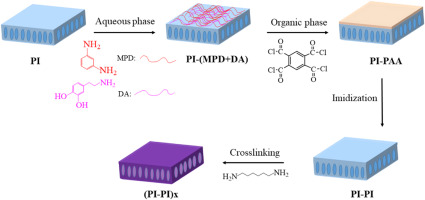当前位置:
X-MOL 学术
›
J. Membr. Sci.
›
论文详情
Our official English website, www.x-mol.net, welcomes your
feedback! (Note: you will need to create a separate account there.)
High Solvent-resistant and Integrally Crosslinked Polyimide-based Composite Membranes for Organic Solvent Nanofiltration
Journal of Membrane Science ( IF 8.4 ) Pub Date : 2018-10-01 , DOI: 10.1016/j.memsci.2018.06.048 Can Li , Shuxuan Li , Li Lv , Baowei Su , Michael Z. Hu
Journal of Membrane Science ( IF 8.4 ) Pub Date : 2018-10-01 , DOI: 10.1016/j.memsci.2018.06.048 Can Li , Shuxuan Li , Li Lv , Baowei Su , Michael Z. Hu

|
Abstract This paper reports a new class of integral polyimide (PI)-based thin film composite (TFC) membranes (with improved solvent resistance in both the skin layer and the substrate) for organic solvent nanofiltration (OSN). The OSN membrane was prepared via interfacial polymerization (IP) onto a PI ultrafiltration (UF) substrate, followed by an imidization, a chemical crosslinking, and a solvent activation process. During the IP process, m-phenylenediamine (MPD), dopamine (DA), and 1,2,4,5-benzene tetracarboxylic acyl chloride (BTAC) were respectively used as an aqueous monomer, an aqueous additive, and an organic monomer. We proved that amide bonding formed between MPD and the PI substrate during the immersion of the substrate in the aqueous MPD solution, thus providing a strong binding between the substrate and the subsequently formed skin layer of polyamide acid (PAA), which was formed due to reaction between MPD and BTAC during the IP process. DA contains amine group and could also help build a strong binding between the substrate and the skin layer during the same IP process. The subsequent imidization step converted the PAA molecules of the skin layer into PI polymers, which was quite similar to that of the substrate. The final crosslinking step crosslinked not only the inner molecules of the skin layer, and the inner molecules of the substrate, but also the interface molecules between the skin and substrate so as to form an integral composite membrane with improving solvent resistance. The fabricated OSN membranes under optimal preparation conditions exhibited an ethanol permeance of 2.03 L m−2 h−1 bar−1 with a rejection of 98% for Rhodamine B (479 Da) and exhibited an outstanding organic solvent resistance without compromising separation performance during the persistent immersion in DMF at 80 °C for two weeks, indicating a promising prospective in OSN applications.
中文翻译:

用于有机溶剂纳滤的高耐溶剂整体交联聚酰亚胺基复合膜
摘要 本文报道了一类用于有机溶剂纳滤 (OSN) 的新型整体聚酰亚胺 (PI) 基薄膜复合 (TFC) 膜(表层和基材均具有改进的耐溶剂性)。OSN 膜通过界面聚合 (IP) 制备到 PI 超滤 (UF) 基材上,然后进行酰亚胺化、化学交联和溶剂活化过程。在 IP 过程中,间苯二胺 (MPD)、多巴胺 (DA) 和 1,2,4,5-苯四甲酰氯 (BTAC) 分别用作水性单体、水性添加剂和有机单体。我们证明了在将基材浸入 MPD 水溶液期间,在 MPD 和 PI 基材之间形成了酰胺键,因此在基材和随后形成的聚酰胺酸 (PAA) 表层之间提供了强结合,这是由于 IP 过程中 MPD 和 BTAC 之间的反应而形成的。DA 含有胺基团,还有助于在同一 IP 过程中在基材和表层之间建立牢固的结合。随后的酰亚胺化步骤将表层的 PAA 分子转化为 PI 聚合物,这与基材的非常相似。最后的交联步骤不仅交联了表层的内部分子和基材的内部分子,而且还交联了表皮和基材之间的界面分子,从而形成了具有提高耐溶剂性的整体复合膜。在最佳制备条件下制造的 OSN 膜的乙醇渗透率为 2。
更新日期:2018-10-01
中文翻译:

用于有机溶剂纳滤的高耐溶剂整体交联聚酰亚胺基复合膜
摘要 本文报道了一类用于有机溶剂纳滤 (OSN) 的新型整体聚酰亚胺 (PI) 基薄膜复合 (TFC) 膜(表层和基材均具有改进的耐溶剂性)。OSN 膜通过界面聚合 (IP) 制备到 PI 超滤 (UF) 基材上,然后进行酰亚胺化、化学交联和溶剂活化过程。在 IP 过程中,间苯二胺 (MPD)、多巴胺 (DA) 和 1,2,4,5-苯四甲酰氯 (BTAC) 分别用作水性单体、水性添加剂和有机单体。我们证明了在将基材浸入 MPD 水溶液期间,在 MPD 和 PI 基材之间形成了酰胺键,因此在基材和随后形成的聚酰胺酸 (PAA) 表层之间提供了强结合,这是由于 IP 过程中 MPD 和 BTAC 之间的反应而形成的。DA 含有胺基团,还有助于在同一 IP 过程中在基材和表层之间建立牢固的结合。随后的酰亚胺化步骤将表层的 PAA 分子转化为 PI 聚合物,这与基材的非常相似。最后的交联步骤不仅交联了表层的内部分子和基材的内部分子,而且还交联了表皮和基材之间的界面分子,从而形成了具有提高耐溶剂性的整体复合膜。在最佳制备条件下制造的 OSN 膜的乙醇渗透率为 2。































 京公网安备 11010802027423号
京公网安备 11010802027423号